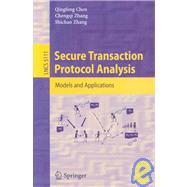
| Introduction | p. 1 |
| What Is Security Protocol? | p. 1 |
| Needs of Formal Analysis for Secure Transaction Protocols | p. 3 |
| Formal Methods and Related Areas | p. 5 |
| Emerging Issues and Trends | p. 10 |
| A Brief Discussion on the Chapters | p. 12 |
| Summary | p. 13 |
| Overview of Security Protocol Analysis | p. 17 |
| The Formalism | p. 17 |
| Basic Notations and Terminology | p. 18 |
| Inference Rules | p. 19 |
| Security Protocols | p. 21 |
| SET Protocol | p. 22 |
| Netbill Protocol | p. 23 |
| Security Services | p. 24 |
| Principles of Cryptography | p. 32 |
| Threats in Security Protocols | p. 38 |
| Research into Analysis of Security Protocols | p. 42 |
| A Discussion of Formal Methods and Security Protocols | p. 42 |
| A Brief Introduction to Protocol Abstraction | p. 44 |
| A Classification of Approaches for Protocol Analysis | p. 47 |
| Attack-Construction Approach | p. 52 |
| Approaches by Dolev and Yao | p. 52 |
| NRL Protocol Analyser | p. 56 |
| Inference-Construction Approach | p. 61 |
| BAN Logic | p. 61 |
| Extensions to BAN Logic | p. 64 |
| Proof-Construction Approach | p. 67 |
| Approaches Using Formal Tools and Specification Languages | p. 68 |
| Summary | p. 71 |
| Formal Analysis of Secure Transaction Protocols | p. 73 |
| Introduction | p. 73 |
| Research into Verifying Electronic Transaction Protocols | p. 75 |
| Formalism for Protocol Analysis Using Process Calculi | p. 75 |
| Formal Analysis Using an Observational Transition System | p. 78 |
| Formal Analysis of Card-Based Payment Systems in Mobile Devices | p. 80 |
| A Computational Model | p. 83 |
| Basic Terms and Statements | p. 86 |
| Logical Framework and Statement of ENDL | p. 89 |
| Axiom | p. 90 |
| Inference Rules | p. 94 |
| Inference Format | p. 99 |
| Verification Instances of Security Protocols in ENDL | p. 99 |
| Summary | p. 106 |
| Model Checking in Security Protocol Analysis | p. 107 |
| An Overview of Model Checking in Analysing E-Commerce Protocols | p. 108 |
| Model Checking for Failure Analysis of Protocols | p. 109 |
| Automatic Analysis of E-commerce Protocols Using UML | p. 111 |
| An ENDL-Based Verification Model | p. 113 |
| Components | p. 113 |
| Designing the Model | p. 114 |
| Handling the Knowledge and Facts | p. 117 |
| Recognition | p. 118 |
| Comparison with Theorem Proving | p. 125 |
| Discussion | p. 127 |
| Summary | p. 129 |
| Uncertainty Issues in Secure Messages | p. 131 |
| Introduction | p. 131 |
| Estimation of Inconsistency of Secure Messages | p. 134 |
| Related Work | p. 134 |
| Semantics Description | p. 137 |
| Measuring Inconsistency in Secure Messages | p. 144 |
| Examples of Measuring Inconsistency | p. 151 |
| Experiments | p. 153 |
| Integration of Conflicting Beliefs in Secure Messages | p. 156 |
| Related Work | p. 157 |
| Basic Concepts | p. 159 |
| Handling Inconsistent Beliefs in Secure Messages | p. 165 |
| Experiments | p. 170 |
| Summary | p. 172 |
| Applications of Data Mining in Protocol Analysis | p. 175 |
| Introduction | p. 175 |
| Related Work | p. 177 |
| Basic Concepts | p. 180 |
| Association Rule Mining for Inconsistent Secure Messages | p. 182 |
| The Basics of Association Rule Mining | p. 182 |
| Data Preparation | p. 184 |
| Identifying Association Rules of Interest | p. 186 |
| Algorithms and Experiments | p. 188 |
| Algorithms | p. 188 |
| Experiments | p. 189 |
| Summary | p. 192 |
| Detection Models of Collusion Attacks | p. 193 |
| Introduction | p. 193 |
| Related Work | p. 195 |
| Identification of Frequent Patterns for Collusion Attack Detection | p. 198 |
| Basic Concepts | p. 198 |
| A Framework to Detect Collusion Attacks | p. 200 |
| Dealing with Knowledge and Facts | p. 202 |
| A Case Study | p. 203 |
| Estimation of the Probability of Collusion Attacks | p. 205 |
| Motivations | p. 205 |
| Preliminaries | p. 206 |
| Identifying Collusion Attack Using Bayesian Network | p. 208 |
| Experiments | p. 212 |
| Summary | p. 215 |
| Conclusion and Future Works | p. 217 |
| Conclusion | p. 217 |
| Future Work | p. 219 |
| References | p. 223 |
| Index | p. 233 |
| Table of Contents provided by Ingram. All Rights Reserved. |
The New copy of this book will include any supplemental materials advertised. Please check the title of the book to determine if it should include any access cards, study guides, lab manuals, CDs, etc.
The Used, Rental and eBook copies of this book are not guaranteed to include any supplemental materials. Typically, only the book itself is included. This is true even if the title states it includes any access cards, study guides, lab manuals, CDs, etc.